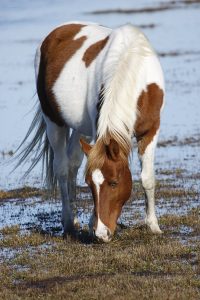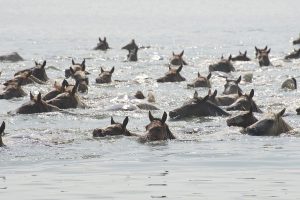On the last Thursday in July, the wild ponies on Virginia's Assateague Island will make their annual swim, opens a new window across to Chincoteague Island. Many of the foals will be auctioned off to raise money for the local fire department, just as they have since 1925. The custom of rounding up the ponies is much older, dating back to the 1700s at least, and it has always been held with a lot of celebration. Today, you and your family can visit Chincoteague during Pony Penning, enjoy a carnival and great seafood, and perhaps bring home your very own foal.
The first ponies on Assateague are believed to have been survivors of a shipwrecked Spanish galleon, opens a new window. Today's ponies aren't purebred from those Spanish horses. Off and on, the Islanders have added mustangs, Arabians, Shetland ponies, Welsh ponies, and their own horses to the mix to keep the bloodlines healthy.
Chincoteague ponies may be wild, but they receive excellent care. Over the years, the herd sometimes grows beyond what the land can support. The annual auction helps keep just enough ponies on the island so they won't starve. During the swim, "saltwater cowboys" from the local fire department ride along to make sure nothing goes wrong. A vet comes to the island twice a year to check on them, and a farrier goes out to trim their hooves so they will be comfortable and safe.
When Marguerite Henry wrote Misty of Chincoteague, opens a new window, suddenly the whole world learned about the wild ponies. When a terrible storm hit the islands in 1962 (Stormy, Misty's Foal), the author and the real Misty made appearances at showings of the Misty movie, opens a new window to raise funds for the devastated community.
Today, you can visit Chincoteague, either during Pony Penning Week in July or anytime. Chincoteague is where the people live. Assateague, managed as a National Park Service property, is where the ponies live. Visitors can come during the day to Assateague, enjoy the beach, and watch the sunset. Just don't feed the ponies. They are wild creatures, and being close to humans isn't good for them - or the humans. If you visit in the spring or fall, the ponies are still there, the weather is cooler, and the migrating birds make the island especially beautiful. You could camp out, stay at a bed and breakfast, a cottage, or a hotel. When you cross the bridge to Assateague, you may see ponies grazing in the salt grass, just as they have for hundreds of years.
Whether you can visit the island in person or not, you can check out Marguerite Henry's Chincoteague pony books: Misty of Chincoteague;, opens a new window Stormy, Misty's Foal;, opens a new window Sea Star, opens a new window; and Misty's Twilight, opens a new window.
Here's a little pony lingo to get you on your way to being an equine expert:
What makes a pony different from a horse? Size, of course! Traditionally, horses are measured in hands, not inches. A hand equals four inches. They're not measured to the tops of their heads but to their withers - the part that's right under the front of the saddle. A pony measures in under 14 hands, two inches (or, 58 inches). Any more than that, and you're looking at a horse, not a pony. Most Chincoteague ponies stand about 12 hands (48 inches) high.
A lot of the Chincoteague ponies are spotted. These ponies are called pintos. In Great Britain, opens a new window, a pinto horse or pony with a bay (brown) or chestnut (shades of red) or any other color besides black background color is called a skewbald. A black horse with white pinto-style markings is called a piebald, as in "Pie," the amazing jumper in Enid Bagnold's classic racehorse story, National Velvet, opens a new window.
Click here, opens a new window to see all of our children's books on horses and ponies available from the library. Any of them can be reserved for pick up at your favorite branch, opens a new window.



